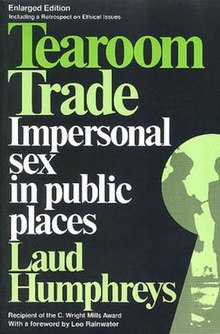Tearoom Trade
 |
|
| Author | Laud Humphreys |
|---|---|
| Country | United Kingdom |
| Language | English |
| Subject | Homosexuality |
| Publisher | Duckworth |
|
Publication date
|
1970 |
| Media type | |
| Pages | 180 |
| ISBN | |
Tearoom trade: a study of homosexual encounters in public places is a 1970 book by Laud Humphreys, whose Ph.D. dissertation was also titled "Tearoom trade". The study is an analysis of homosexual acts taking place in public toilets. Humphreys asserted that the men participating in such activity came from diverse social backgrounds, had differing personal motives for seeking homosexual contact in such venues, and variously self-perceived as "straight," "bisexual," or "gay." His study called into question some of the stereotypes associated with the anonymous male-male sexual encounters in public places, demonstrating that many of the participants lived otherwise conventional lives as family men and respected members of their communities, and that their activities posed no danger of harassment to straight males. Because the researcher misrepresented his identity and intent and because the privacy of the subjects was infringed during the study, Tearoom Trade has caused a major debate on privacy for research participants and is now often used as an example of highly controversial social research.
The book is an ethnographic study of anonymous male homosexual sexual encounters in public toilets (a practice that was known as "tea-rooming" in U.S. gay slang and "cottaging" in British English).
Humphreys was able to observe and describe various social cues (body language, hand language, etc.) developed and used by participants in those places. The encounters usually involved three people: the two engaged in the sexual activity, and a look-out, called "watchqueen" in slang. By offering his services as the "watchqueen," Humphreys was able to observe the activities of other participants.
38% of Humphreys' subjects were neither bisexual nor homosexual; 24% were clearly bisexual; 24% were single and were covert homosexuals, and only 14% corresponded to the popular stereotype of homosexuality - clear members of the gay community interested in primarily homosexual relationships. Because Humphreys was able to confirm that 54% of his subjects were outwardly heterosexual men with unsuspecting wives at home, an important thesis of Tearoom Trade is the incongruity between the private self and the social self for many of the men engaging in this form of homosexual activity. Specifically, they put on a "breastplate of righteousness" (social and political conservatism) in an effort to conceal their deviation from social norms.
...
Wikipedia
